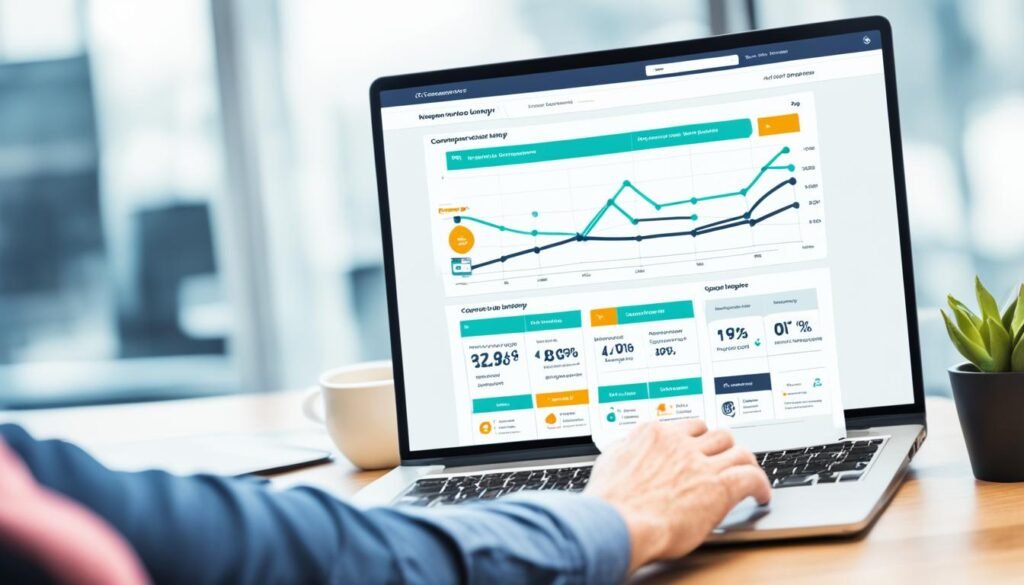Analytics tracking is a crucial aspect of your digital marketing strategy. It allows you to collect and interpret data that enhance your online presence, providing valuable insights into user behaviour on your website. Tools like Google Analytics and Adobe Analytics play a significant role in this process, enabling you to generate detailed reports on traffic sources and engagement metrics. By effectively utilising analytics tracking, you can adapt your strategies to better meet your audience’s needs, ultimately boosting your website metrics and improving overall performance.
Table of Contents
ToggleKey Takeaways
- Analytics tracking is essential for understanding user interaction on your website.
- Effective data analysis leads to informed decision-making.
- Tools like Google Analytics can streamline your tracking efforts.
- Understanding visitor behaviour helps in refining marketing strategies.
- Continuous monitoring improves website metrics over time.
Understanding Analytics Tracking
Analytics tracking plays a crucial role in the digital landscape, enabling you to gather meaningful insights about user interactions on your website. By focusing on the importance of analytics, you can effectively convert data into strategies that enhance user engagement and drive conversions.
Definition and Importance
Analytics tracking involves the systematic collection and analysis of data related to user behaviour. This process helps you uncover patterns and trends, allowing for informed decision-making. The importance of analytics cannot be overstated; it not only provides clarity regarding audience preferences but also reveals areas for improvement in your online presence. Understanding user behaviour highlights which aspects of your site resonate most with visitors, ultimately guiding your digital marketing efforts towards greater efficiency and effectiveness.
How it Fits into Digital Marketing
In the realm of digital marketing, analytics tracking is indispensable. It facilitates deeper understanding of customer journeys and allows you to tailor your strategies accordingly. By leveraging data from analytics, you can optimise marketing campaigns, ensuring your messages reach the right audience at the right time. In turn, these insights empower you to allocate resources wisely, maximising your return on investment and fostering sustained growth.
https://www.youtube.com/watch?v=PN7KfMfj__o
Key Components of Analytics Tracking
Understanding the key components of analytics tracking allows you to leverage effective strategies in your digital marketing efforts. This includes integrating various data analysis techniques alongside sophisticated user behaviour monitoring tools that can significantly enhance your website’s performance.
Data Analysis Techniques
Data analysis forms the backbone of your understanding of user interactions. Techniques such as descriptive analytics summarise historical data to identify trends over time, while predictive analytics employs algorithms to forecast potential future activities. These methods provide a robust framework for decision-making, allowing you to tailor your marketing efforts more effectively.
User Behaviour Monitoring Tools
Utilising user behaviour monitoring tools enhances your ability to assess how visitors interact with your site. Tools like heatmaps and session recordings offer valuable insights into navigation patterns. These analytics tools allow you to pinpoint strengths and weaknesses in user experience, facilitating opportunities for optimisation. By focusing on these elements, you can improve engagement and conversion rates, fostering a more efficient digital presence.
Implementing Effective Analytics Tracking
To establish a strong foundation for analytics tracking, your first step involves selecting the right analytics software. Quality software provides the necessary tools for comprehensive tracking and insightful reporting, enabling a deeper understanding of user interactions and campaign effectiveness.
Choosing the Right Software
Several options are available when it comes to analytics software. Popular platforms, like Google Analytics, deliver robust features for monitoring traffic and user behaviour. For more advanced user tracking, consider solutions like Mixpanel or Kissmetrics. Each platform offers unique capabilities, so evaluating your specific needs is essential to find the best fit for your business.
Setting Up Conversion Tracking
Conversion tracking plays a vital role in assessing your marketing efforts. By tracking user actions, such as purchases or sign-ups, you can measure key performance indicators (KPIs) effectively. Establish clear goals within your analytics software to ensure that the data you collect provides valuable insights into which strategies are driving results.
Utilising A/B Testing for Improvement
A/B testing empowers you to enhance your website’s performance systematically. By creating variations of your web pages and measuring their effectiveness against one another, you gather important data on user preferences. Incorporating A/B testing into your analytics routine can lead to improved user engagement and higher conversion rates, ultimately benefiting your overall marketing strategy.
![]()
| Analytics Software | Key Features | Best For |
|---|---|---|
| Google Analytics | Traffic monitoring, user segmentation | Basic to intermediate users |
| Mixpanel | Advanced user tracking, event reporting | Product managers and developers |
| Kissmetrics | Customer engagement, retention tracking | E-commerce and subscription models |
| Crazy Egg | Heatmaps, A/B testing tools | UI/UX designers |
Maximising Insights Through Analytics Tracking
To gain valuable insights from analytics tracking, you must delve into customer journey analytics. This process carefully examines every interaction a customer has with your brand. Recognising where customers face obstacles can clarify enhancement opportunities.
Customer Journey Analytics Explained
Implementing customer journey analytics gives you a comprehensive view of the customer’s path. By mapping each touchpoint, you can identify critical moments that dictate customer satisfaction and loyalty. This understanding helps in driving targeted improvements, ultimately enhancing the overall customer experience.
Using Heatmaps for User Interaction
Heatmaps serve as a powerful tool for visually analysing user interactions. You gain insights into where users click most frequently, scroll, and hover on your website. This visual representation allows you to assess where your design elements are performing well and where changes might be necessary to align better with user behaviour.
Funnel Optimisation Strategies
Funnel optimisation strategies focus on the steps customers take towards completing a conversion. Analysing these stages allows you to pinpoint drop-off points, which is essential to increasing conversion rates. By streamlining these processes, you create a more efficient experience that encourages customers to complete their desired actions.

| Analytics Strategy | Purpose | Benefit |
|---|---|---|
| Customer Journey Analytics | Identify touchpoints and pain points | Enhances customer experience |
| Heatmaps | Visualise user engagement | Informs design improvements |
| Funnel Optimisation | Analyse conversion steps | Increases conversion rates |
Conclusion
In summary, analytics tracking is an indispensable tool for any business striving to enhance its digital marketing optimisation. By utilising the data insights obtained through diligent tracking and analysis of user behaviours, you are empowered to make informed decisions that can significantly improve your campaign outcomes.
The continuous monitoring and refinement of your analytics tracking efforts promise not only to elevate user engagement but also to bolster the overall success of your marketing strategies. Embracing a data-driven approach allows you to swiftly adapt to changing market dynamics, ensuring you effectively meet your customers’ needs.
In this ever-evolving digital landscape, incorporating robust analytics tracking methods will drive better results and provide a competitive edge. By leveraging the power of these insights, your business can thrive and flourish in today’s digital marketplace.




